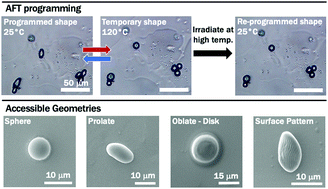Permanent and reversibly programmable shapes in liquid crystal elastomer microparticles capable of shape switching†
Abstract
Reversibly programmable liquid crystal elastomer microparticles (LCEMPs), formed as a covalent adaptable network (CAN), with an average diameter of 7 μm ± 2 μm, were synthesized via a thiol-Michael dispersion polymerization. The particles were programmed to a prolate shape via a photoinitiated addition–fragmentation chain-transfer (AFT) exchange reaction by activating the AFT after undergoing compression. Due to the thermotropic nature of the AFT-LCEMPs, shape switching was driven by heating the particles above their nematic–isotropic phase transition temperature (TNI). The programmed particles subsequently displayed cyclable two-way shape switching from prolate to spherical when at low or high temperatures, respectively. Furthermore, the shape programming is reversible, and a second programming step was done to erase the prolate shape by initiating AFT at high temperature while the particles were in their spherical shape. Upon cooling, the particles remained spherical until additional programming steps were taken. Particles were also programmed to maintain a permanent oblate shape. Additionally, the particle surface was programmed with a diffraction grating, demonstrating programmable complex surface topography via AFT activation.



 Please wait while we load your content...
Please wait while we load your content...
